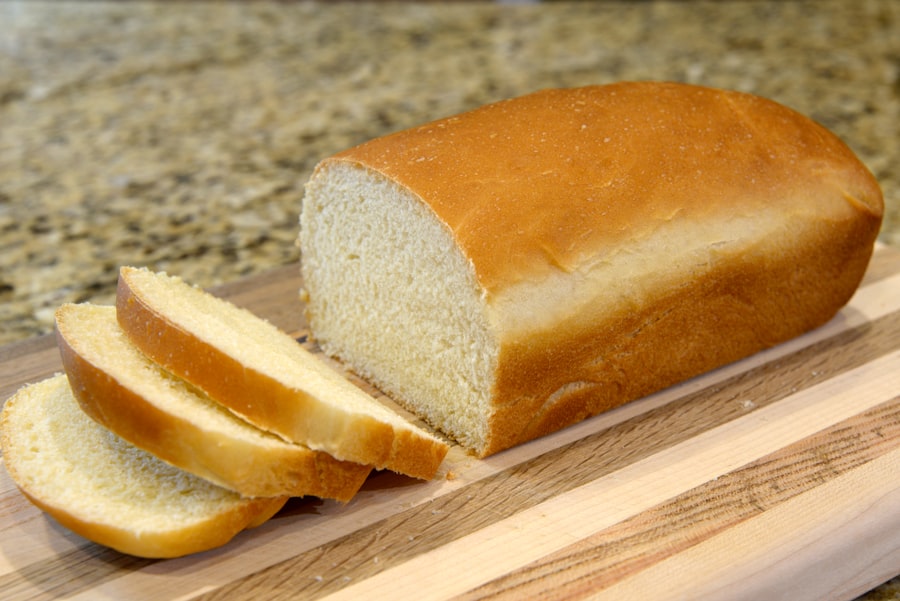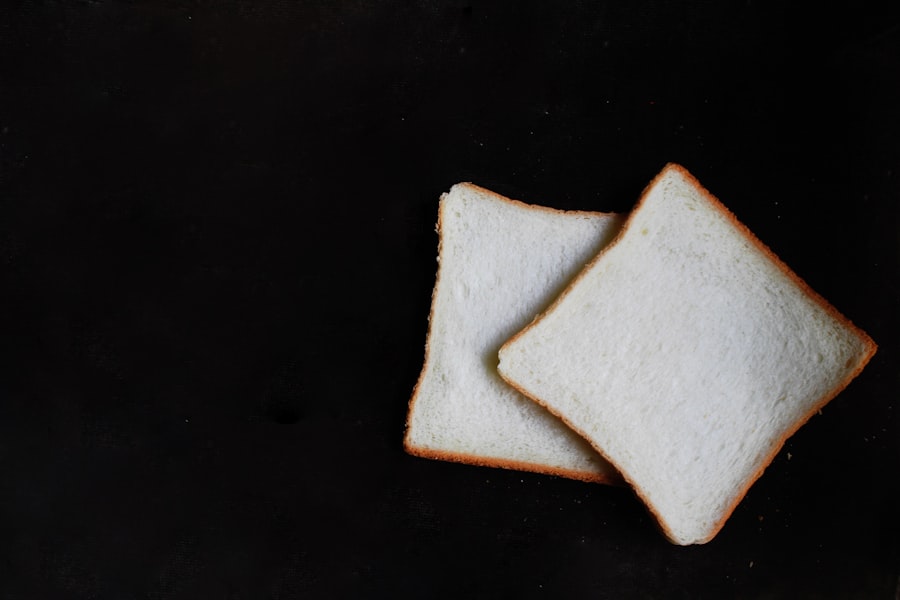As you age, your body undergoes various changes that can affect how it processes food, particularly carbohydrates. White bread, a staple in many diets, is made from refined flour that has been stripped of its fiber and nutrients. When you consume white bread, your body quickly breaks it down into glucose, leading to rapid spikes in blood sugar levels.
This can be particularly concerning for seniors, as fluctuating blood sugar can lead to a host of health issues, including fatigue, irritability, and even long-term complications like diabetes. For seniors, maintaining stable blood sugar levels is crucial for overall health and well-being. The quick digestion of white bread means that you may experience a surge of energy followed by a crash, leaving you feeling tired and sluggish.
This rollercoaster effect can be detrimental, especially if you have existing health conditions or are on medications that affect blood sugar regulation. By understanding the link between white bread and blood sugar spikes, you can make more informed dietary choices that support your health as you age.
Key Takeaways
- White bread can cause blood sugar spikes in seniors, leading to potential health issues.
- Consumption of white bread can contribute to weight gain in seniors due to its high glycemic index.
- Seniors who consume white bread may be at an increased risk of developing diabetes.
- White bread can have a negative impact on heart health in seniors due to its effect on cholesterol levels.
- Seniors may experience digestive issues as a result of consuming white bread.
How White Bread Contributes to Weight Gain in Seniors
Weight management becomes increasingly important as you grow older, and the foods you choose play a significant role in this process. White bread is often high in calories but low in nutritional value, making it easy to overconsume without feeling satisfied. When you eat white bread, the lack of fiber means that you may not feel full for long, leading to additional snacking or larger portion sizes at meals.
This cycle can contribute to unwanted weight gain, which can further complicate health issues such as joint pain and cardiovascular problems. Moreover, the refined carbohydrates found in white bread can lead to increased fat storage in the body. As your metabolism naturally slows with age, your body may struggle to burn off these excess calories effectively.
This can create a vicious cycle where weight gain leads to decreased mobility and energy levels, making it even harder to maintain a healthy lifestyle. By recognizing how white bread can contribute to weight gain, you can take proactive steps to choose healthier alternatives that support your weight management goals.
The Role of White Bread in Increasing the Risk of Diabetes in Seniors

The relationship between white bread consumption and diabetes risk is particularly concerning for seniors. As mentioned earlier, the rapid digestion of white bread leads to spikes in blood sugar levels. Over time, consistently high blood sugar can result in insulin resistance, a precursor to type 2 diabetes.
For seniors, who may already be at a higher risk for developing diabetes due to age-related factors, consuming white bread can significantly increase this risk. Additionally, the glycemic index (GI) of white bread is relatively high compared to whole grain alternatives.
By opting for whole grain or low-GI alternatives instead of white bread, you can help mitigate your risk of developing diabetes and promote better overall health.
White Bread and its Impact on Heart Health in Seniors
| Study Group | White Bread Consumption | Impact on Heart Health |
|---|---|---|
| Group 1 | High | Increased risk of heart disease |
| Group 2 | Low | Lower risk of heart disease |
| Group 3 | None | No impact on heart health |
Heart health is a critical concern for seniors, as cardiovascular diseases become more prevalent with age. The consumption of white bread can negatively impact heart health due to its high glycemic index and low fiber content. Diets high in refined carbohydrates have been linked to increased levels of triglycerides and LDL cholesterol—both risk factors for heart disease.
When you consume white bread regularly, you may inadvertently increase your chances of developing heart-related issues. Furthermore, the lack of essential nutrients in white bread means that it does not contribute positively to your heart health. Whole grains are rich in fiber, vitamins, and minerals that support cardiovascular function and help maintain healthy blood pressure levels.
By replacing white bread with whole grain options, you can improve your heart health and reduce the risk of developing serious conditions such as hypertension or heart attacks.
The Connection Between White Bread and Digestive Issues in Seniors
As you age, digestive health often becomes a more pressing concern. White bread is low in fiber, which is essential for maintaining healthy digestion. A diet lacking in fiber can lead to constipation and other gastrointestinal issues that are particularly troublesome for seniors.
When you consume white bread regularly, you may find yourself struggling with digestive discomfort or irregular bowel movements. In contrast, whole grain breads are rich in dietary fiber, which promotes regularity and supports a healthy gut microbiome. By choosing whole grain options over white bread, you can enhance your digestive health and reduce the likelihood of experiencing uncomfortable symptoms.
This simple dietary change can make a significant difference in how you feel on a daily basis.
White Bread and its Effect on Bone Health in Seniors

Bone health is another critical aspect of aging that can be influenced by your diet.
As you age, your bones naturally become more fragile, making it crucial to consume foods that support bone density.
Relying on white bread as a dietary staple may hinder your ability to meet these nutritional needs. Incorporating whole grains into your diet instead of white bread can provide additional benefits for bone health. Whole grains often contain more vitamins and minerals that contribute to bone strength.
By making this switch, you not only improve your overall nutrition but also take proactive steps toward preserving your bone health as you age.
The Impact of White Bread on Cognitive Function in Seniors
Cognitive decline is a common concern among seniors, and diet plays a significant role in brain health. Consuming high amounts of refined carbohydrates like those found in white bread may negatively impact cognitive function over time. Research suggests that diets high in sugar and refined carbs can lead to inflammation and oxidative stress in the brain, both of which are linked to cognitive decline and conditions such as Alzheimer’s disease.
By choosing whole grain alternatives instead of white bread, you can provide your brain with the nutrients it needs to function optimally. Whole grains are rich in antioxidants and other beneficial compounds that support brain health and may help protect against cognitive decline. Making this simple dietary change could have lasting effects on your mental acuity as you age.
White Bread and its Influence on Energy Levels in Seniors
Energy levels often fluctuate as you age, and what you eat plays a crucial role in how energized you feel throughout the day. White bread is known for causing rapid spikes and subsequent crashes in blood sugar levels, which can leave you feeling fatigued and lethargic. When you consume white bread, the quick release of glucose provides an initial burst of energy but is often followed by a significant drop that can leave you feeling drained.
In contrast, whole grain breads provide a more sustained source of energy due to their higher fiber content. The slow digestion of whole grains helps maintain stable blood sugar levels, allowing for more consistent energy throughout the day. By opting for whole grain alternatives over white bread, you can help ensure that your energy levels remain steady and reliable as you navigate daily activities.
The Relationship Between White Bread and Inflammation in Seniors
Chronic inflammation is a common issue among seniors and can contribute to various health problems such as arthritis and heart disease. Diet plays a significant role in inflammation levels within the body, and consuming refined carbohydrates like white bread may exacerbate this issue. The high glycemic index of white bread can lead to increased inflammation markers in the body, which can worsen existing conditions or lead to new health challenges.
By choosing whole grain options instead of white bread, you may help reduce inflammation levels within your body. Whole grains contain anti-inflammatory compounds that support overall health and well-being. Making this dietary switch could be an effective way to combat chronic inflammation and improve your quality of life as you age.
White Bread and its Role in Aging and Skin Health in Seniors
As you age, skin health becomes increasingly important for maintaining a youthful appearance and overall well-being. Diet plays a crucial role in skin health, with certain foods promoting elasticity and hydration while others may contribute to premature aging. White bread is often devoid of essential nutrients that support skin health, such as vitamins A, C, and E.
In contrast, whole grains are rich in antioxidants and other beneficial compounds that help protect the skin from oxidative stress and promote a healthy complexion. By replacing white bread with whole grain alternatives, you not only improve your overall nutrition but also take proactive steps toward maintaining healthy skin as you age.
Alternatives to White Bread for Seniors to Maintain a Healthy Diet
If you’re looking to improve your diet as a senior while reducing your reliance on white bread, there are plenty of delicious alternatives available. Whole grain breads are an excellent choice; they provide more fiber and nutrients than their white counterparts while still offering the comforting texture of traditional bread. You might also consider sprouted grain breads or sourdough options that are easier on digestion.
Other alternatives include wraps made from whole grains or even lettuce leaves for sandwiches if you’re looking for a low-carb option. Additionally, experimenting with different types of grains like quinoa or farro can add variety to your meals while providing essential nutrients that support overall health. By making these simple substitutions, you can enjoy satisfying meals while promoting better health outcomes as you age.
In conclusion, understanding the impact of white bread on various aspects of health is crucial for seniors looking to maintain their well-being as they age. By making informed dietary choices and opting for healthier alternatives, you can significantly improve your quality of life while reducing the risk of chronic diseases associated with aging.
Seniors should consider avoiding white bread due to its high glycemic index, which can lead to spikes in blood sugar levels. This is particularly important for older adults who may be managing diabetes or are at risk of developing it. White bread is also low in essential nutrients and fiber, which are crucial for maintaining digestive health and preventing constipation, a common issue among seniors. For more detailed information on dietary choices that can benefit senior health, you can read this related article on Explore Senior Health. This resource provides insights into healthier alternatives and tips for maintaining a balanced diet in later years.
WATCH THIS!🧠 The Breakfast Mistake That Fuels Senior Memory Loss
FAQs
Why should seniors avoid white bread?
White bread is made from refined flour, which has been stripped of its nutrients and fiber during processing. This can lead to spikes in blood sugar levels, which can be harmful for seniors, especially those with diabetes or pre-diabetes.
What are the health risks associated with white bread for seniors?
Eating white bread regularly can contribute to weight gain, increase the risk of type 2 diabetes, and lead to heart disease. It can also cause digestive issues and exacerbate existing conditions such as constipation.
What are the healthier alternatives to white bread for seniors?
Seniors can opt for whole grain bread, which contains more fiber and nutrients than white bread. Other alternatives include whole wheat bread, rye bread, and sprouted grain bread, which offer more health benefits and are better for managing blood sugar levels.
How can seniors make the switch from white bread to healthier alternatives?
Seniors can gradually introduce healthier bread options into their diet by starting with a mix of white and whole grain bread, and then gradually increasing the proportion of whole grain bread over time. They can also experiment with different types of healthier bread to find one that suits their taste preferences.
